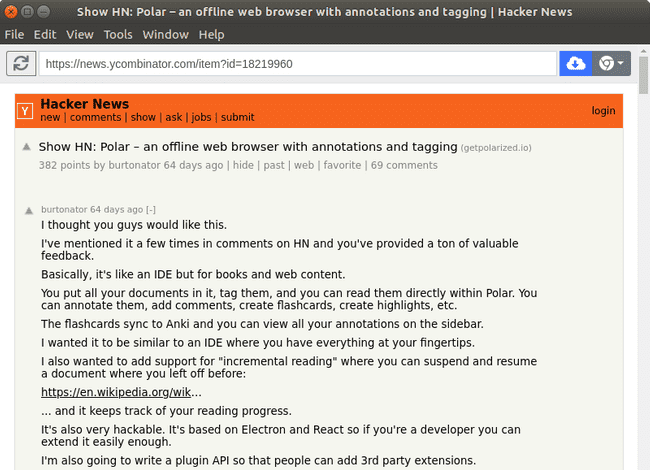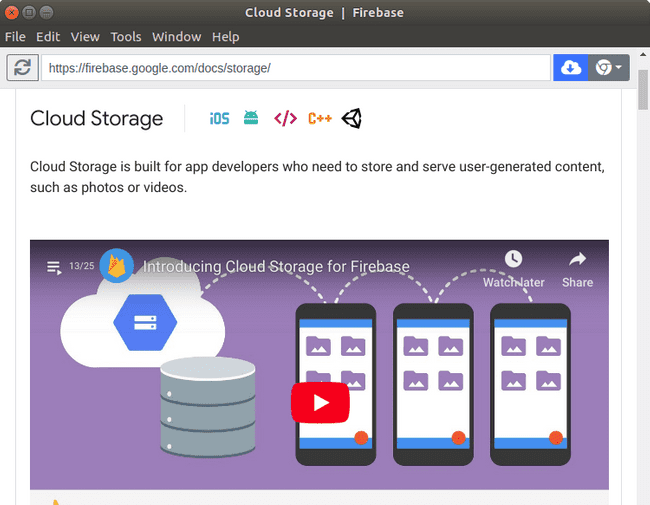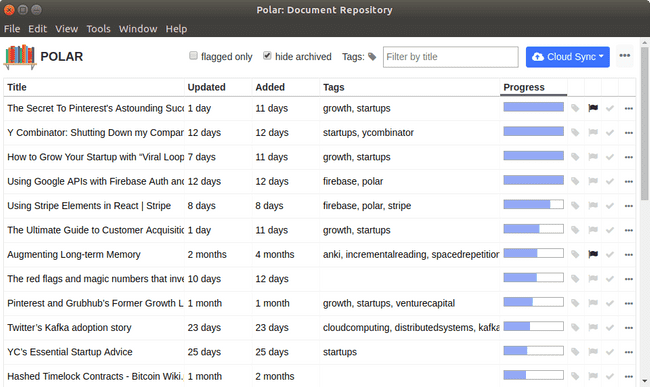Web Page Capture
Polar supports long term web page archival via a process called "capture" which downloads and caches the content locally. We store it in Polar as if it were any other type of document (like PDF).
This allows you to manage web pages with tags and annotations including text and area highlights, comments, and flashcards.
This essentially allows Polar to work like your own personal Internet archive for documents critical to your education and maintain the knowledge contained within using annotations and comments and use incremental reading to read large collections of web pages in parallel.
One issue with annotating documents on the web is that the author might change the document (or even delete it) thereby invalidating your annotations.
Polar prevents that by capturing the content on disk (and in the cloud) for your own long term usage.
During this process we fetch the full HTML, including iframes, and store them in a portable PHZ file that can be used for long term archival of web content.
Additionally, we capture the document in a way to make them more usable and more readable.
Readability
Polar supports capturing the document in a more readable form by emulating tablet and mobile devices during capture.
Websites usually try to cooperate with tablets and mobile devices by making them more readable on smaller screens.
With Polar we emulate these devices during capture to preserve web pages in a more readable form - often with sidebar and navigational content removed.
Document Captured with Sidebar
Captured as Tablet with Sidebar Removed
Link Rot
Capture prevents the problem of "link rot" where URLs vanish from the web over time due to a natural form of attribution. Either the domain expires or the content is deleted or the location changed.
The Internet Archive has found that more than 9M URLs on Wikipedia return 404 error pages.
With Polar you never have to worry about this being an issue as you have a permanent long term copy of important content.
Usage
To capture a new page just select File | Capture Web Page then enter a URL.
A preview window will show what the page will look like in Polar.
After that you have to click the 'capture' button to the top right and a new document will be saved within Polar.
Document Repository
After the web page is captured and saved locally it's saved to the document repository where you can reference it at any time in the future.
The document repository supports features like tagging, tracking reading progress, custom sorting (by updated time, added time), etc.
Chrome Extension
The Polar Chrome Extension allows you to send directly from Chrome into Polar. You can copy the URL and paste it into Polar directly but it's more convenient to have a one click button in integrated into your browser.
Design
Light, Thin, Fat, Full Archives.
We define the following archive types:
- light: URL only (not supported yet)
- thin: HTML only with iframes. No CSS, images, audio, or video (supported in Polar 1.x)
- fat: HTML + CSS + images. No audio or video. (under development)
- full: HTML + CSS plus all resources including images, audio, and video (not supported yet).
Why not use a standard format.
I would have loved to. I didn't want to build a document format and spend months doing so.
We're lucky captured pages work AT ALL.
What are the challenges of creating a portable HTML archive that mandates something custom.
- CORS access policies prevent the content being access programmatically for things like screenshots.
- CORS prevents loading resources from our origin and the target origin
Why not MHTML
- Firefox doesn't support MHTML
- MHTML doesn't support images
- We can't extend it, fix bugs in it, etc.
Why not WARC
- Chrome can't replace an HTTP response while it's served. Only send a redirect. This means that you end up building a loader ANYWAY which is 90% of the requirements for Polar.
- WARC doesn't support compression settings for individual entries. We only STORE images/video for performance and storage gains.
- With WARC the full HTTP request would need to be replayed. With our content capture we're able to use in-browser assets and cache to rebuild the page.
- We also cleanup and strip javavascript.
- WARC would only represent the storage, not the extraction. It might be possible to WRITE WARC or have export to WARC though.
 Polar
Polar


